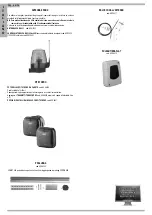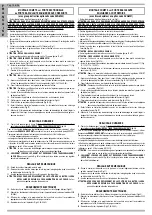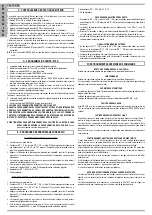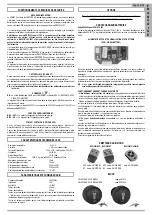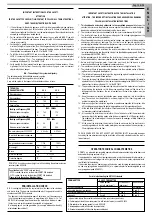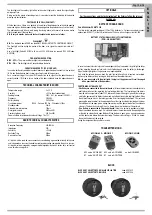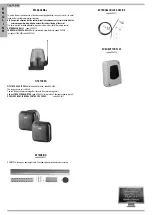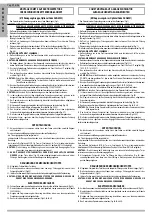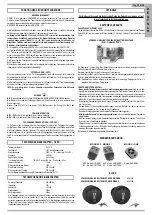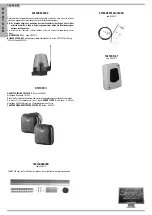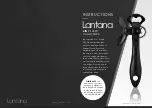
Pag. 18 di 28
C - MOTOR ROTATION DIRECTION CHECK
This control aims to facilitate the operator during the installation of the system, or during possible
further checks.
1 - Set Dip1 on ON => The led DL2 starts to lighten.
2 - Press and keep pressed the button PROG. (now the movement is carried out with a man
present, open-stop-close-stop-open-etc.) => the door closes.
3 - Press and keep pressed the button PROG => the door opens.
4 - Carry out the calibration of the mechanic opening clamp (present on the operator)
5 - Carry out the calibration of the deceleration speed => set the R15 trimmer at the minimum =>
press the button and keep it pressed=> after 3 seconds the slowing down starts.
Verify that the motor has power enough to move the door both when opening and closing.
Contrariwise, increase the value set on the trimmer until the optimal condition for working is
reached.
7 - At the end of the check set DIP1 back on OFF => TheDL2 led switches off thus signalling the
exit from the check.
N.B.
: During this check the ENCODER and the courtesy light are active.
D - TIMES PROGRAMMING (DIP 2)
1 - The programming must start with the completely open door.
2 - Set the micro switcher Dip 2 on ON => The DL2 led will emit short flashings
3 - Press the button PROG. => the door closes.
4 - Once the door is close, the ENCODER stops the motor.
5 - After two seconds the door opens automatically.
6 - Once the mechanic opening clamp is reached, the ENCODER stops the motor (with encoder
and time readings) and the waiting time calculation before the automatic closing becomes
active (max 5 minutes).
7 - Press the button PROG. => The waiting time calculation before the automatic closing stops
and the door closes. In the same moment, the DL2 led stops lightening thus signalling the exit
from the machine learning procedure.
From this moment the safeties or other controls of the door will normally work (reversals, stop,
alarms, etc....).
8 - The closing of the door will be carried out in speed mode and in the proximity of the total
closing in slow down mode.
9 - Once the ENCODER calculation is over, the door stops.
AT THE END OF THE PROGRAMMING PUT THE DIP 2 BACK ON OFF.
DURING THE PROGRAMMING THE SAFETIES ARE ACTIVE AND THEIR INTERVENTION
STOPS THE PROGRAMMING (THE LED DL2 WHICH WAS LIGHTENING NOW HAS A
COSTANT LIGHT ). TO REPEAT THE PROGRAMMING SET THE DIP 2 ON OFF), CLOSE THE
DOOR FOLLOWING THE PROCEDURE “MOTOR ROTATION SENSE CHECK” AND REPEAT
THE PROGRAMMING DESCRIBED ABOVE.
ATTENTION: EACH TIME THE MECHANICAL STOPPER IS ADJUSTED (MOVED) IT IS
NECESSARY TO PROGRAMME AGAIN THE TRAVEL OF THE TROLLEY.
Programming can be done every time is required.
E - RADIO CODE LEARNING PROCEDURE
FOR MOTOR CONTROL (MAX 8 CODES):
1 - To be carried out when the door is close.
2 - Set DIP 1 - ON and subsequently DIP 2 - ON => DL2 programming led will lighten with a
frequency of 1 sec. ON e 1 sec. OFF for 10 seconds, witch is the time required for they code’s
programming.
3 - Press the remote control button (normally the
A channel
) within the 10 set seconds. If the
remote control is correctly read in, the courtesy light emits a flashing.
4 - The codes’ programming time is automatically renewed to read in the following remote control.
5 - To end the programming wait 10 seconds, or press for a while the PROG. button => DL2
programming led will stop lightening.
6 - Re-set DIP 1 - OFF and DIP 2 - OFF.
7 - End of the procedure.
FOR COURTESY LIGHT ONLY (MAX 8 CODES):
1 - To be carried out when the door is close.
2 - Set DIP 2 - ON and subsequently DIP 1 - ON => DL2 programming led will lighten with a
frequency of 1 sec. ON e 1 sec. OFF for 10 seconds, witch is the time required for they code’s
programming.
3 - Press the remote control button (normally the
B channel
) within the 10 set seconds. If the
remote control is correctly read in, the courtesy light emits a flashing.
4 - The codes’ programming time is automatically renewed to read in the following remote control.
5 - To end the programming wait 10 seconds, or press for a while the PROG. button => DL2
programming led will stop lightening.
6 - Re-set DIP 1 - OFF and DIP 2 - OFF.
7 - End of the procedure.
RADIO CODES CANCELLATION PROCEDURE:
1 - Set DIP 1 - ON and subsequently DIP 2 - ON (to read in the motor control codes) or set DIP 2 -
ON and subsequently DIP 1-ON (to read in the courtesy light control codes)
2 - DL2 programming led will lighten with a frequency of 1 sec. ON e 1 sec. OFF for 10 seconds.
3 - During the 10 seconds => press and keep pressed the PROG. Button for 5 seconds => the
memory cancellation is signalled by two flashings of the courtesy light.
4 - Subsequently DL2 programming led stays active and it is possible to add new codes following
the procedures described above.
MEMORY SATURATION SIGNALING
1 - By setting DIP 1 - ON and subsequently DIP 2 -ON (to read in the motor control codes) or by
setting DIP 2 - ON and subsequently DIP 1 - ON (to read in the courtesy light control codes)
2 - The courtesy light lightens for 6 times thus signalling that the memory is full.
3 - Subsequently the DL2 programming led stays active for 10 seconds, thus enabling the possible
total cancellation of the codes.
CONTROL FITTINGS OPERATION
STEP BY STEP CONTROL BUTTON (COM-K)
It carries out a cyclic control of open-stop-close-stop-open-etc. controls.
REMOTE CONTROL
It carries out a cyclic control of open-stop-close-stop-open-etc. controls.
It is possible to control only the courtesy light (see codes learning procedure for courtesy light
control)
AUTOMATIC CLOSING
The pause times before the automatic closing of the door are recorded during the times
programming.
The max. pause time is 5 minutes.
The pause time can be activated or deactivated through DIP3 (ON - active).
RELEASE FACILITATION
With DIP 5 ON, when the closing will be completed a reversal manoeuvre will be carried out for a
fixed time of 0,2s to facilitate the manual release.(in this phase the ENCODER is not enabled)
COURTESY LIGHT
It is activated to the opening and closing controls for a fixed time of 3 minutes, the time is renewed
if a command is given when the light is still on.
It is possible to control the courtesy light only through the radio control for 3 minutes (see codes
learning procedure for courtesy light control).
Also this time is renewed if a radio command is given when the light is still on.
BATTERY FUNCTIONING WITH BLACK OUT
If two 12V – 1,2 Ah batteries are connected in series to the recharge card positioned in the
gearcase, with lack of voltage the door opens and closes normally, the battery state pilot light
(optional) switches on thus signalling the functioning with the battery. The functioning of the door
is ensured up to a voltage level of about 20V, after which we have a signalling (given by the
recharge card to the gearcase) which blocks the door and makes the battery state pilot light
lighten.
When the network voltage returns, the recharge card starts charging the battery and the battery
state led switches off.
It is sufficient to press the remote control (or the K button ) to open the door.
When the bar is door, give a closing command or wait the pause time before the automatic closing
=> the door starts closing.
When closed, the normal functions are reactivated.
RESTART AFTER BLACK OUT
When the voltage is back, giving a command the door will open and as long as it hasn’t carried out
a complete cycle (opens+closes) the encoder will interpret any impact as the end of the stroke.
Consequently, it is obligatory to make COMET S carry out a complete cycle to realign the
parameters, after which the encoder will also work as safety for obstacle survey.
SAFETY FITTINGS OPERATION
ENCODER (INCORPORATED)
COMET S is equipped with an incorporated ENCODER to put, in case there is an obstacle, the
door’s motion into reverse during the opening phase and the closing phase.
Often, normal current sensors do not allow the reversal during the last centimetres of the running.
RIB Encoder is conform to what required by EN60335-2-95 standards.
It has the duty to act as security, both during the closing and the opening phase, with reversal of
the movement and define the stroke during the programming.
With reference to EN 12453 standard on the point 5.5.2. => non automatic single family
doors (automatic closing deactivated) which assembly an operator conform to the
EN60335-2-95:2001 and that do not lean on public access areas, can avoid to assembly
protection devices against deflection, shearing and conveyance points.
It is possible to exclude the ENCODER functioning only as security through the JUMPER JP1 (ON).
In case the ENCODER should not work (not fed, disconnected wires or faulty) the movement of
the door is not carried out (the ENCODER is an active security).
If after a first intervention of the ENCODER in closing or opening phase there is a second one,
obviously in the contrary sense, the door stops and then reverses for 1 sec.
E
N
G
L
I
S
H





